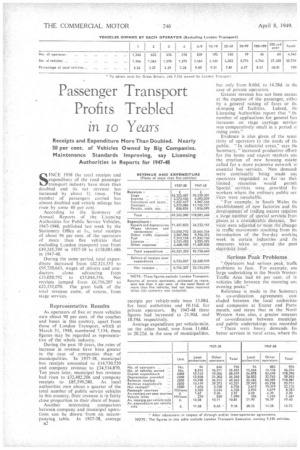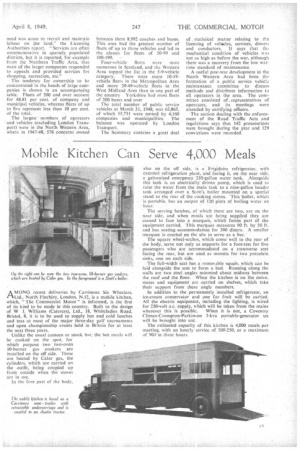Passenger Profits in io Transport Trebled Years
Page 10

Page 11

If you've noticed an error in this article please click here to report it so we can fix it.
Receipts and Expenditure More Than Doubled. N early. 50 per cent. of Vehicles Owned by Big Companies. Maintenance Standards Improving, say Licensing Authorities in Reports for 1947-48
SINCE 1938 the total receipts and expenditure of the road passenger transport industry have more than doubled and its net revenue has increased by about 3, times. The number of passengers carried has almost doubled and vehicle mileage has risen by some 40 per cent.
According to the Summary of Annual Reports of the Licensing Authonities for Public Service Vehicles, 1947-1948, published last week by the Stationery Office at Is., total receipts of about 96 per cent. of the operators of more than five vehicles (but excluding London transport) rose from £49,245,390 in 1937-38 to £118,081,486 in 1947-48.
During the same period, total expenditure increased from £42,521,353 to £95,750,643, wages of drivers and conductors alone advancing from £13,050,792 to £35,044,556. Net receipts jumped from £6,756,207 to £22,132,070. The great bulk of the total revenue came, of course, from stage services.
Representative Results
As operators of five or more vehicles own about 90 per cent. of the coaches and buses in this country, apart from those of London Transport, which at March 31, 1948, numbered 7,134, these figures may be regarded as representative of-the whole industry.
During the past 10 years, the rates of increase in revenue have been greater in the case of companies than of municipalities. TO 11937-38, municipal bus receipts amounted to £14,730,520 and company revenue to £34,514,870. Ten years later, municipal bus revenue had risen to £32,482,206 and company
receipts to . £85,599,280. As local authorities own about a quarter of the total number of public service vehicles in this country, their revenue is in fairly close proportion to their share of .buses.
Another interesting comparisorl. between company and municipal operations can be drawn from an accompanying .table. In 1937-38, average
B2 receipts per vehicle-mile Were 13.08d. for local authdrities and 10.11d. for private operators. By 1947-48 these figures had increased to 21.90d. and .18.59d. respectively.
Average expenditure per vehicle-mile. on the other hand, rose from I1.68d. to 20.22d. in the case of municipalities,
but only from 8.60d. to 14.28d. in tl-K case of private operators.
Greater revenue has not been earnec at the expense of the passenger, eithei by a general raising of fares or thi. skimping of facilities. Indeed, thi. Licensing Authorities report that " th, number of applications for general fart increases on stage carriage service! was comparatively small in a period ol rising costs."
Evidence is also given of the sensi. tivity of operators to the needs of tht public. "In industrial areas," says au Summary, "increased productive effort, for the home and export markets am the erection of new housing estate! called for a more extensive network ol essential bus:services. New demand, were continually being made ant operators reSponded as far ',as theil _limited resources would permit Special' services were _ provided foi 'workers where the ordinary public ser .Vices were unsuitable.
"For example, in South Wales tht 'establishment of new factories and thi ,developMent.of trading estates require( a large nOmber of special services fron places at a eciniiderah.le.distance,. Services were adjusted to meet the change, in traffic movements resulting from tht introduction of the five-day workim week: in certain -industries and tilt measures taken to spread .the peak electricitY Serious Peak -Problems ".:Operators had serious,peak. traffic problems to face. For example, otu large undertaking in the North Westerr Traffic Area had 64 per cent, of it vehicles idle between the morning ant evening peaks."
Reference is made in the Summar) to co-ordination agreements con. eluded between the local authoritiei and companies at Exeter and Ports. mouth,' and states that in the Nortl Western Area also, a greater measur( of .co-ordination between rnunicipa and public undertakings was recorded
"There were heavy demands foi better services in rural areas, where th%
need was acute to recruit and maintain labour on the land," the Licensing Authorities report. "Services are often unremunerative in sparsely populated districts, but it is reported, for example from the Northern Traffic Area, that must of the larger companies responded to appeals and provided services for shopping, recreation, etc."
The tendency for ownership to be concentrated in the hands of large companies is shown in an accompanying table. Fleets of 200 and over accomn for 48.81 per cent. of company and municipal vehicles, whereas fleets of up to five represent less than 10 per cent. of the total.
The largest numbers of operators and vehicles (excluding London Transport) were in the North Western Area, where in 1947-48, 576 concerns owned between them 8,992 coaches and buses. This area had the greatest number of fleets of up to three vehicles and led in the classes for fleets of 50-99 and 100-199.
Four-vehicle fleets were most numerous in Scotland, and the Western Area topped the list in the 5-9-vehicle category. There were more 10-19vehicle fleets in the Metropolitan Area and more 20-49-vehicle fleets in the West Midland Area than in any part of the country 'Yorkshire had most fleets of 200 buses and over The total number of public service vehicles at March 31, 1948; was 62,865, of which 55,731 were owned by 4;160 companies and municipalities. The balance was operated by London Transport.
The Suminary contains a great deal
of ._statistical matter relating to the licensing of vehicles, services, drivers and Conductors. It says that the mechanical condition of vehicles was riot as high as before the war, although thei-e was a recovery from the low wartime standard of maintenance.
A useful post-war development in the North Western Area had been the formation of a „public service vehicle maintenance committee to discuss methods and distribute information to all operators in the area. The committee consisted of .representatives of
operators, and„, meetings were attended by certiying officers.
The Section dealing with the enforcement of the Road Traffic Acts and 'regulations Says that 142 prosecutions were brought 'during the year-and 129 convictions were recorded.


























